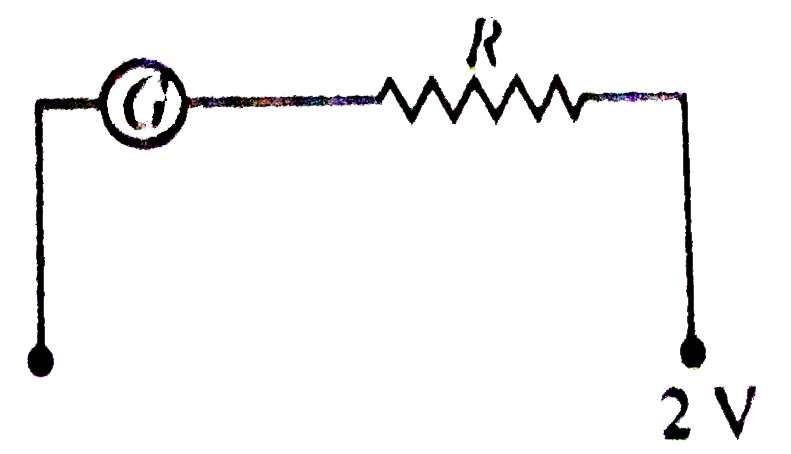Two galvanometers A and B require 3 mA and 6 mA respectively, to produce the same deflection of 10 divisions. Then,
A is more sensitive than B
B is more sensitive than A
A and B are equally sensitive
sensitiveness of B is twice that of A
The correct Answer is:A
To determine which galvanometer, A or B, is more sensitive, we can follow these steps:
Step 1: Understand Sensitivity
Sensitivity of a galvanometer is defined as the amount of current required to produce a certain deflection. It is inversely proportional to the maximum current that can be passed through the galvanometer for a given deflection.
Step 2: Identify Given Values
From the problem, we know:
- Galvanometer A requires 3 mA to produce a deflection of 10 divisions.
- Galvanometer B requires 6 mA to produce the same deflection of 10 divisions.
Step 3: Write the Sensitivity Relationship
Let the sensitivity of galvanometer A be SA and that of galvanometer B be SB. According to the definition of sensitivity:
SA∝1IAandSB∝1IB
where IA and IB are the currents required for the same deflection.
Step 4: Calculate the Sensitivity Ratio
We can express the ratio of sensitivities as:
SASB=IBIA
Substituting the values we have:
SASB=6mA3mA=2
Step 5: Interpret the Result
This means:
SA=2×SB
This indicates that galvanometer A is more sensitive than galvanometer B.
Conclusion
Thus, galvanometer A is the more sensitive galvanometer.
---
Sensitivity of a galvanometer is defined as the amount of current required to produce a certain deflection. It is inversely proportional to the maximum current that can be passed through the galvanometer for a given deflection.
From the problem, we know:
- Galvanometer A requires 3 mA to produce a deflection of 10 divisions.
- Galvanometer B requires 6 mA to produce the same deflection of 10 divisions.
Let the sensitivity of galvanometer A be SA and that of galvanometer B be SB. According to the definition of sensitivity:
SA∝1IAandSB∝1IB
where IA and IB are the currents required for the same deflection.
We can express the ratio of sensitivities as:
SASB=IBIA
Substituting the values we have:
SASB=6mA3mA=2
This means:
SA=2×SB
This indicates that galvanometer A is more sensitive than galvanometer B.
Thus, galvanometer A is the more sensitive galvanometer.
Topper's Solved these Questions
- CURRENT ELECTRICITYBOOK - DC PANDEY ENGLISHCHAPTER - CURRENT ELECTRICITYEXERCISE - Taking it together
142 Videos
- CURRENT ELECTRICITYBOOK - DC PANDEY ENGLISHCHAPTER - CURRENT ELECTRICITYEXERCISE - B. Assertion and reason
18 Videos
- CURRENT ELECTRICITYBOOK - DC PANDEY ENGLISHCHAPTER - CURRENT ELECTRICITYEXERCISE - Example
65 Videos
- COMMUNICATION SYSTEMBOOK - DC PANDEY ENGLISHCHAPTER - COMMUNICATION SYSTEMEXERCISE - Subjective
11 Videos
- ELECTROMAGNETIC INDUCTIONBOOK - DC PANDEY ENGLISHCHAPTER - ELECTROMAGNETIC INDUCTIONEXERCISE - Medical entrances gallery
25 Videos
Similar Questions
Knowledge Check
A galvanometer of resistance 40Ω gives a deflection of 5 divisions per mA. There are 50 divisions on the scale. The maximum current that can pass through it when a shunt resistance of 2Ω is connected is
A210mAB155 MaC420mAD75 MaA galvanometer coil has a resistance of 15Ω and the metre shows full scale deflection for a current of 4 mA. To convert the meter into a voltmeter of range 0 to 18 V, the required resistance is
A5885Ωin seriesB4485Ωin seriesC5885Ωin seriesD4485Ωin series
A galvanometer has a resistance of 30 ohm and a current of 2 mA is needed to give a full scale deflection. What is the resistance needed and how is it to be connected to convert this galvanometer
(a) Into an ammeter of 0.3 A range ?
(b) Into a volmeter of 0.2 V range ?
View SolutionA voltmeter which can measure 2 V isconstructed by using a galvanometer of resistance 12Ω and that produces maximum deflection for the current of 2mA. Then the resistance R is

View SolutionA galvanometer vaving 50 divisions provided with a variable shunt S is used to measure the current when conneted in series with a resistance of 90Ω and a battery of internal resistance 10Ω. It is observed that when the snt resistaces are 10Ω&70Ω respectively, the deflection are respectively 9 and 30 dividions. What is the resistance of the galvanometer ? Further, if the full scale deflection of the galvanometer movement require 200 mA. find the emf of the cell.
View SolutionA galvanometer of resistance 30Ω is connected to a battery of emf 2 V with 1970Ω resistance in series. A full scale deflection of 20 divisions is obtained in the galvanometer. To reduce the deflection to 10 divisions, the resistance in series required is
View SolutionDeflection of galvanometer in the circuit is 71 divisions. A shunt of 15Ω is connected parallel to galvanometer and value of R is adjusted such that main current ramains the same. If the deflection in the galvanometer falls to 15 divisions then the resistance G of galvanometer in (in ohm)

View SolutionThe galvanometer shown in figure has resistance 50 Ω and current required for full scale deflection is 1mA. Find the resistance R1,R2 and required to convert to convert it into ammeter having ranges as indicated.

View Solution
